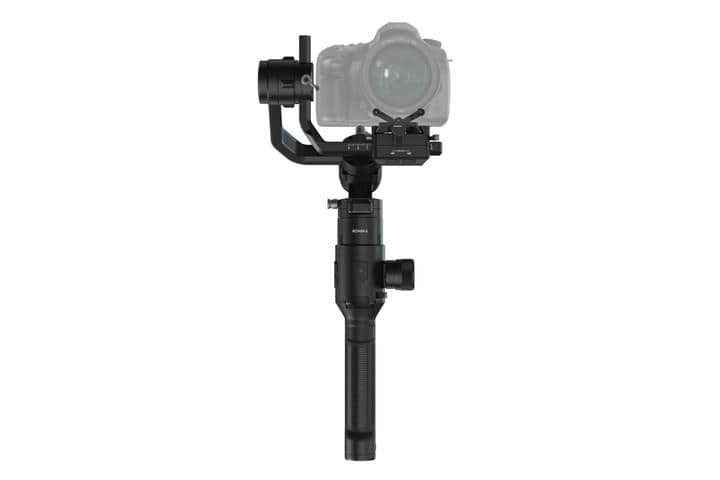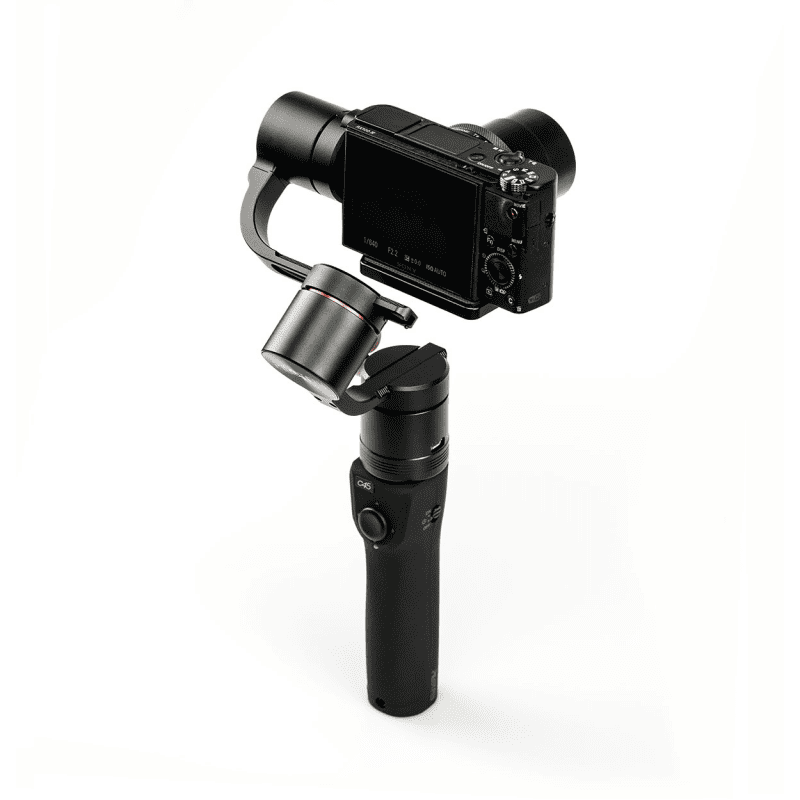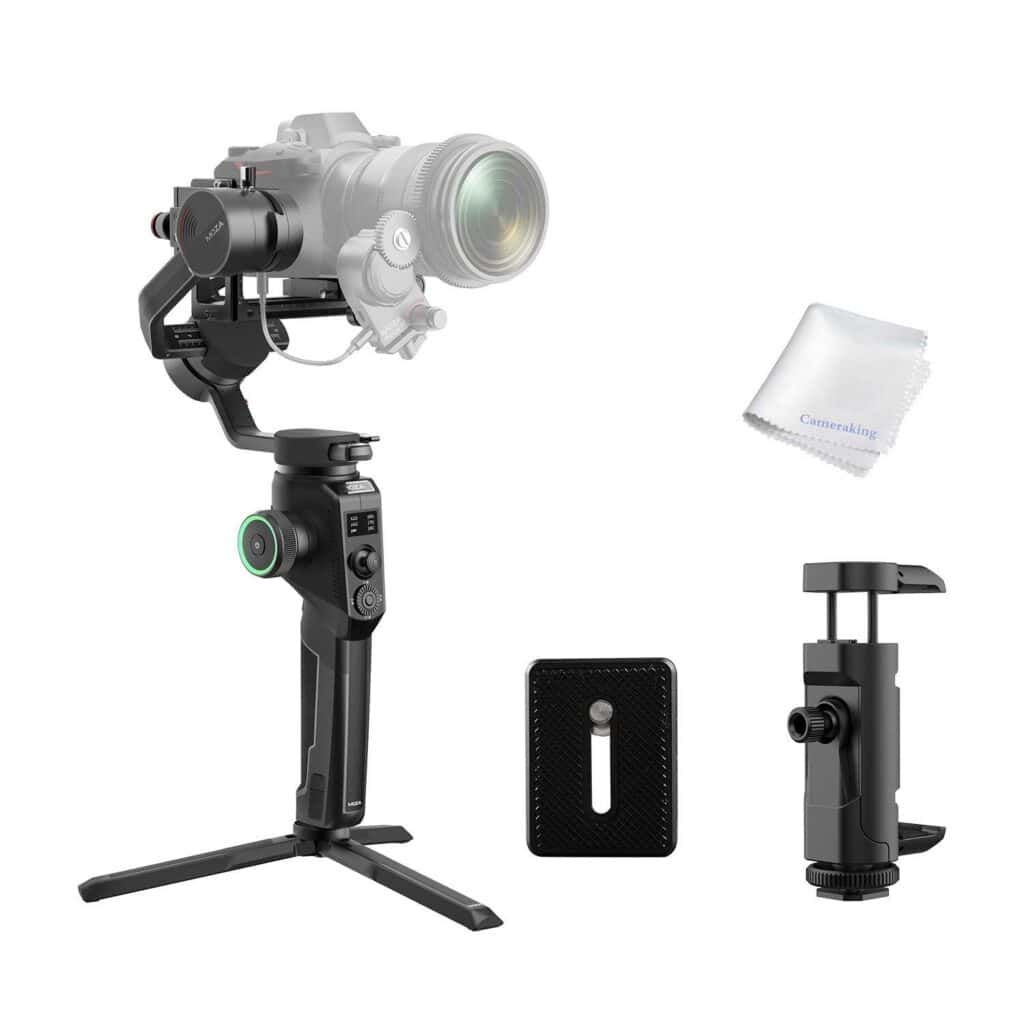
MOZA AirCross 2 Gimbal 3-Axis Handheld Stabilizer
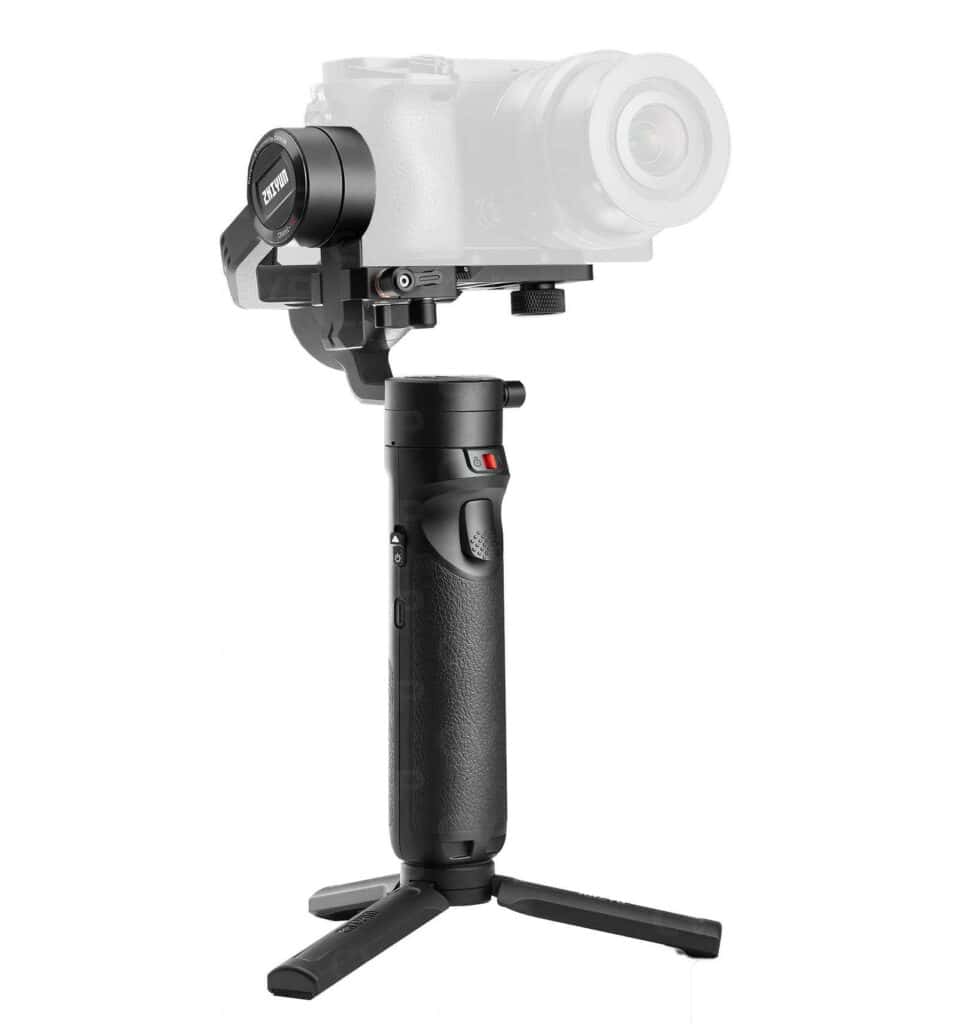
Zhiyun Crane M2
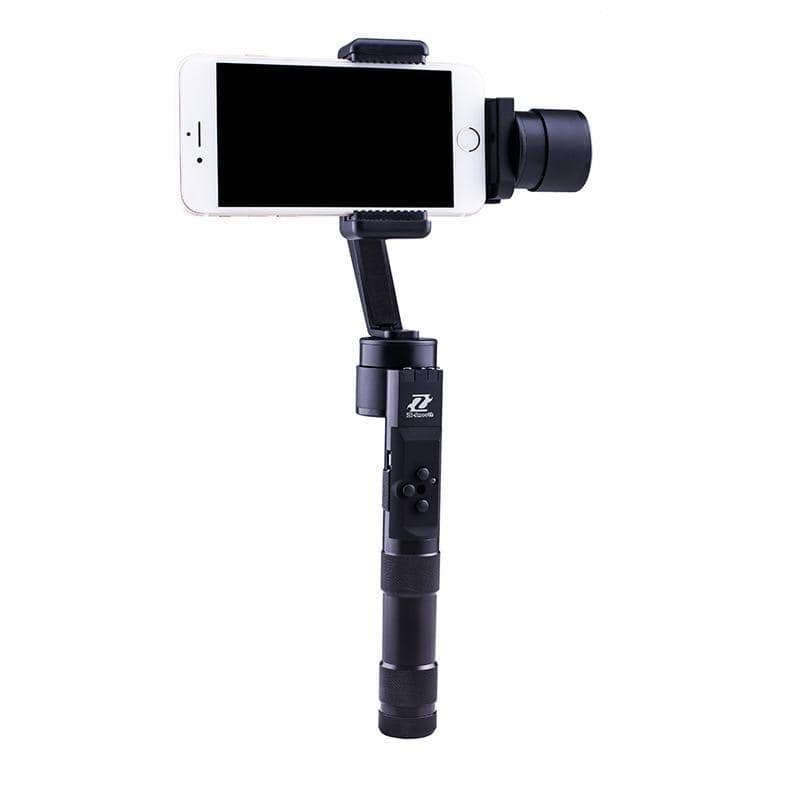
Zhiyun Smooth C
Videography and Photography is a very competitive, and taking good-quality shots is necessary to get the viewer’s attention. You need to ensure that the consumer of your content is completely delighted with the images you shoot.
This means that getting a fantastic DSLR, even a Sony RX100, won’t guarantee great results if you do not have the right equipment.
What better way to increase production than having excellent equipment gimbals? So, if you’re looking for a gimbal for your Sony RX100, you should acquire the best one to obtain the best results.
Unfortunately, this part is very complicated; choosing from many options makes it very difficult to decide which one will produce better results with Sony RX100.
In this blog, we will bring you the best gimbals you can buy for Sony RX100. It will give you a clear idea of what kind of results you can expect from these gimbals and which one you should buy for your usage.
Top 5 Picks of Square Waffle Makers
Things To Consider While Choosing The Best Gimbals For Sony RX100
There are plenty of gimbals available in the market, but not all of them are compatible with your Sony RX100. So, before buying a gimbal for your Sony RX100, you need to ensure that it is compatible with your device.
Here are some things to consider while choosing the best gimbals for Sony RX100:
Gimbal Mounting System:
The gimbal mounting system can either be a screw-based or clamp-based system. While screw-based systems provide more flexibility and compatibility options, they are often difficult to assemble and disassemble.
On the other hand, clamp-based systems offer less flexibility but are easy to assemble and disassemble.
Gimbal Weight:
The weight of the gimbal matters a lot when choosing the best one for your smartphone. You should never choose a heavy gimbal as it will make using your phone difficult.
So, if you want to choose one with less weight, go with one with a lighter body and other parts. The lighter ones are usually cheaper than, the heavier ones, so you can get them at affordable prices too!
Battery Life:
The battery life of the gimbal needs to be considered. The average battery life for most gimbals is about 7-8 hours. However, some models have a longer battery life than others.
If you plan to shoot long videos or photos, you will need to choose a gimbal with long battery life. You can also buy extra batteries, so you do not have to worry about running out of power while shooting videos and photos.
Size:
Before buying any gimbal, it is important to know about its size so that it fits easily in your hands and does not add extra weight to your bag. If the gimbal is too big, then carrying it around might not be possible for everyone because of its weight and size.
So, always check the gimbal size before buying it so you can easily carry it around without any issues.
Compatibility of Camera with Gimbal:
The gimbal should be compatible with your camera so you can use it without any problem. If you choose a gimbal that is incompatible with your camera, you will not be able to fit it on your camera easily.
So, make sure the device is compatible with your gadget before buying it.
Performance:
The performance of a gimbal determines how well it works with your camera. Some models are compatible with only one type of camera, while others work with many types of cameras.
You should also check if it is compatible with your specific model so that you don’t waste money on an accessory that will not be useful to your needs.
Ease Of Use:
The best gimbals for Sony RX100 should be easy to set up and use. This means that it should be compatible with your camera and comes with everything you need to mount it. You should also be able to change settings quickly if necessary to get the best possible shot at any time.
Stability:
You should consider stability when choosing a gimbal for your camera. If the gimbal is not stable, then there is no point in using it.
You will end up with shaky videos and photos that do not look good. So make sure you choose a gimbal that offers great stability and works perfectly for you without any issues.
Best Gimbals for Sony RX100
Gimbals are the best way to stabilize your video. They’re affordable, lightweight, and easy to use. They allow you to shoot smooth videos from virtually any angle, even when you’re on the move.
If you own a Sony RX100 V or RX100 IV, you know how good these cameras are at shooting video. But if you want to take your shots to the next level, you only need a gimbal.
Here are some of the best gimbals for the Sony RX100:
1. MOZA AirCross 2 Gimbal 3-Axis Handheld Stabilizer
Specifications
Dimensions
230*330*90mm (folded), 240*170*390mm
Weight
1.050g
Payload
300g – 3.200g
Operating temperature
0-50℃
Operating voltage
7.2V
Static current
200mA
Battery
3000mAh
Charging time
1.5 Hours
Battery Life
12 Hours
The Moza Aircoss 2 Gimbal is a great option for getting comprehensive equipment for the Sony RX100. It can help you execute your projects more smoothly.
Despite this Moza model being a new item on the market, its features and costs have made it a major hit for both users and makers. You can do a lot with AirCross because it has some of the best features for getting you out of difficulties.
The AirCross 2 gimbal is compatible with a variety of attachments, including an iFocus-M wireless lens motor, an Arca-Swiss quick-release plate, and a shoe-mount phone holder.
The AirCross 2 has modes for different kinds of filming, such as Inception mode, which is perfect for dream sequences. It can support loads up to 7 lbs, and the camera rotates continuously when you hold the gimbal differently.
If you’re in the market for a gimbal for your Sony RX100, AirCross is an excellent choice because it has a 12-hour battery life, which makes it one of the longest-lasting gimbals on the market.
Another excellent feature of this gimbal is its 12.6 volts DC input that allows you to easily attach a power bank to the handgrip to charge your phone or tablet while you shoot.
Features of Moza AirCross Gimbal
- Supports DSLR cameras up to 7 lb
- The camera is mounted closer to the motor for improved stability
- Locking system for step-by-step balancing
- Up to 12-hour runtime
- The battery features its own charging port and can easily be plugged directly into a USB charger.
- iOS/Android Moza app
- Auto-tuning AI calculation function
- Angled motor arm for an easy view of your display
Benefits
- Excellent Build Quality
- 4-in-1 convertible design
- Easy vertical/horizontal mode switch
- Outstanding battery life
Drawbacks
- No battery level indicator
2. Zhiyun Crane M2
Specifications
Number of Axes
3-Axis (Pitch, Roll, Yaw)
Load Capacity
0.29 to 1.58 lb / 130 to 720 g
Wireless Protocol
Bluetooth 4.2, Wi-Fi
Battery Runtime
7 Hours
Charging Time
2 Hours
Weight
2.09lb
Dimensions
10.5 x 2.7 x 5.4″
Zhiyun Tech produces one of the best gimbals for DSLRs, Smartphones, and other camera devices. For the past few years, gimbals from the Zhiyun have remained at the top on and off.
The Crane M2 is the successor to the original Crane M, created with smaller, lighter point-and-shoot cameras in mind, such as the Sony RX100.
Zhiyun has combined all of their years of experience with comments from the original Crane M to create the Crane M2, a fantastic piece of equipment.
The Crane M2 quickly established a strong reputation in the community after its debut, and many camera experts believe that it will keep Zhiyun at the top of the table for a longer time.
The Zhiyun Crane M2 Crane is the best gimbal for the Sony RX100, providing smooth performance and high-quality stabilization.
Features of Zhiyun Crane M2
- 360° pan, 310° tilt, and 324° roll rotation
- 7-hour runtime on a built-in battery
- Built-in Wi-Fi and Bluetooth
- OLED display
- One-button quick-release camera mounting system
- Compatible with Moment lenses, filter mounts, and accessories
- No counterweight is required for use with Moment Lenses
Benefits
- Lots of shooting modes
- Easy to use
- Excellent Stability
- Also supports iPhones and small cameras
Drawbacks
- App is unintuitive
- Expensive
3. Zhiyun Smooth C
Specifications
Pan angle
320°
Roll angle
90°
Tilt angle
270°
Max payload
200g
Weight
439g
Operation time
4 hours
Battery type
18350 Li-ion, 3.7V 900mah
Charging Time
2 Hours
The Zhiyun Smooth-C 3-axis gimbal can help you take better videos with your Sony RX100 camera. This lightweight device uses three gyroscopes and three small motors to keep your camera completely still in space, no matter how you move.
The smooth movement video it produces helps keep your subject in the frame, so you don’t have to worry about shaking around too much and losing your target in the frame.
The Smooth-C operates on two 900 mAh 18350 lithium-ion batteries, which you can recharge by plugging the gimbal into either a wall outlet or a USB port.
The batteries give you 3-5 operating hours before needing to be recharged. To recharge the batteries, slide them into the handle of the gimbal and screw them back in place.
The Zhiyun Smooth-C supports updates to its software and is regularly made available. These updates add stability and calibration to the gyroscope, making it a better tool for your photography.
These updates are installed via the micro-USB port on the side of the handle, which the provided cable attaches to.
Features of Zhiyun Smooth-C
- 3-axis handheld gimbal stabilizer for smartphones
- Smartphones between 2.2 and 3.2″ in width supported
- 320° rotation along the pan, tilt, and roll axes
- 5-way joystick
- Short-circuit, reverse, and over-discharge protection.
- Two 2-hour runtime batteries included (can be combined if you use an optional extension tube)
- 1/4″-20 mounting thread on the bottom for use with support gear such as monopods
Benefits
- Solid construction, lightweight design
- Great battery life of up to 4 hours
- Smooth learning curve
- Allows calibration with the available software updates
Drawbacks
- Not waterproof
4. DJI Ronin-S Gimbal
Specifications
Load Weight
3.6kg
Connections
Bluetooth 4.0, USB-C
Weight
3.3lb
Dimensions
Approx. 202x185x486mm
Input Power
- Model: RB1-2400mAh-14.4V
- Type: 18650 LiPo
- Capacity: 2400 mAh
- Energy: 34.56 Wh
Maximum Controlled Rotation Speed
- Pan axis: 360°/s
- Tilt axis: 360°/s
- Roll axis: 360°/s
DJI Ronin-S Gimbal Stabilizer is the perfect tool for videographers and filmmakers who need a compact, single-handle stabilized gimbal.
The Ronin-S, like other gimbals, provides three-axis stabilization using motors that can counteract your camera’s movements and enable automated (or guided) tracking and panning.
The Ronin-S comes with a number of controls: a focus wheel, joystick, trigger, and three buttons on the grip. Depending on the operator’s preference, the focus wheel can be attached to either side of the grip using an Allen wrench. Cables are included for follow focus and remote camera control.
The Ronin-S works with Canon, Panasonic, Nikon, and Sony cameras—including some combinations of cameras and lenses that support full camera communications with focus pulling. DJI continues to add additional support through firmware updates.
DJI also offers a sliding attachment plate compatible with the Manfrotto 501PL-type quick-release plate, allowing you to smoothly transfer from the gimbal to tripods without dismounting your camera.
Features of DJI Ronin-S Gimbal
- 3-axis motorized gimbal head.
- Auto-tune feature for quick gimbal calibration.
- 3.6kg load capacity.
- Integrated follow focus knob.
- Remote camera control (depends on model)
- Button to switch between three sets of custom settings.
- Fully configurable using a smartphone app.
- 12-hour battery life.
Benefits
- Excellent built quality
- Creates stunning and smooth footage with ease
- Easy to set up and calibrate
- Remote camera operation included
Drawbacks
- The included charger could have been improved
5. Pilotfly C45
Specifications
Maximum Controlled Rotation Speed
360deg, 320 Roll, Tilt 320 deg, Pan 360deg
Payload
1.7lbs
Battery Life
6 Hours
Battery
14.8V
Stabilization
3-Axis Gimbal Stabilizer
Dimensions
3.9×14.8×7.7inches
Weight
1.1lb
If you own a Sony RX100 and want to use it with a gimbal, the C45 Pilotfly gimbal is the right choice. It was specifically designed to stabilize your compact camera and deliver smooth footage every time you shoot.
The C45 and RX100 make a great travel photography combination because the C45 is small and lightweight, making it easy to transport and store. The gimbal even comes with a small carrying case, but it can also be stuffed into a good camera bag.
The C45 has a 45-degree offset angle, which enables you to see your Sony RX100 screen while shooting. This feature makes taking pictures with your camera more convenient and flexible.
According to the producers, this Gimbal has a payload of about 1.7 pounds. It includes all necessary attachments and can rotate on three axes without damaging the camera.
But not every gimbal is able to rotate 360 degrees. You can see this as a limitation, but it also gives you more freedom of movement than other gimbals of the same price range.
And in addition to the Panning Angles and Tilt Functions, you can enjoy Rolling Functions.
Features of Pilotfly C45
- 32-bit AlexMos controller with triple MCU technology
- Motors have integrated encoders
- Tool-less design
- 360° pan axis
- Four-way joystick control
- 1/4″-20 threaded hole for attaching to accessories such as boompoles
- Five preconfigured modes
- Auto-invert for all profiles
Benefits
- Comes with a shoulder bag with padding
- Elegance Design
- Sturdy Aluminum construction
Drawbacks
- The remote control is not included
FAQs
Conclusion
The Sony RX100 is still one of the best cameras you can buy. Sony is aware of this, which is why they continue manufacturing them. When the Sony RX100 is used with a quality gimbal, it can produce professional-quality video.
The use of gimbals can make your videos look smooth and shake-free. Gimbals can help you make videos that you wouldn’t be able to make otherwise.
The RX100 can produce stunning cinematography when used with a gimbal, which is a device that stabilizes the camera while shooting.
It is possible to capture footage comparable to a more expensive DSLR. There are several things to consider when choosing the right gimbal for your RX100: cost, size, and stability.

